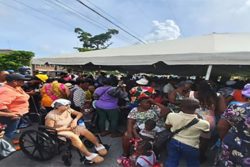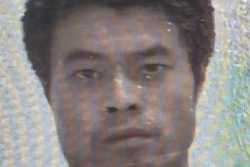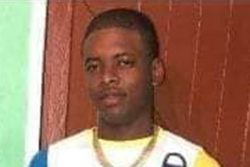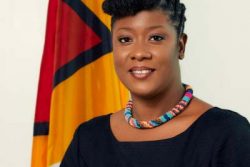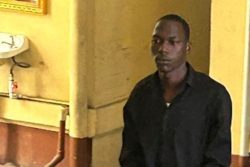 [We are privileged once again to have the opportunity to present another priceless archival document from 1966, the year of Guyana’s Independence. This time it focuses the fine arts, and gives a picture of Guyanese art and artists at that time. The “Art Review” by Basil Hinds was first published in The Chronicle Christmas Annual 1966, which appeared in December, 1966, edited by Charles J. Chichester. Basil Hinds was a foremost Guyanese critic of art and of theatre, who reviewed plays and exhibitions in newspapers for several years.
[We are privileged once again to have the opportunity to present another priceless archival document from 1966, the year of Guyana’s Independence. This time it focuses the fine arts, and gives a picture of Guyanese art and artists at that time. The “Art Review” by Basil Hinds was first published in The Chronicle Christmas Annual 1966, which appeared in December, 1966, edited by Charles J. Chichester. Basil Hinds was a foremost Guyanese critic of art and of theatre, who reviewed plays and exhibitions in newspapers for several years.
We are indebted to George N. Cave who made the article available from his collection. Mr Cave, a linguist, is a former Senior Lecturer at the University of Guyana where he also served as Dean of the Faculty of Arts and University Registrar.]
ART REVIEW by BASIL HINDS
1966 might well be the significant year in this decade for art in Guyana, for it has been a year in which a review of efforts over the last 50 years has been effected, and a period during which strong controversy developed over forward movement, especially among youngsters in the field.
The passing of Edward Rupert Burrowes, M.B.E., the virtual “father” of Guyana painting, is not without significance in this context, and the struggle of youngsters for ascendancy and leadership deepens and heightens at the same instance popular interest in the movement.
The highlight of the year was undoubtedly the REVIEW EXHIBITION OF GUYANESE ART mounted in honour of the visit of Her Majesty Queen Elizabeth II and His Royal Highness the Duke of Edinbourgh in the Art Gallery of the Museum, R.A. & S. C. Building, Georgetown, between February 4 and 12. The show was a success and included paintings done by artists in the early ‘twenties. This review exhibition was made possible by the ready cooperation and courtesy of collectors spread over the country. Most of the artists practicing currently were also represented in the review.Loans from collections
Mr J. Adamson loaned his early Antrobuses – “Landscape, Bel Air” and “Landscape with Cows”.
Represented in the category of landscape was Carlton Allen, now doing Architecture in england, with his “Atkinson Field” (B.G.Museum), a work of geographical and historical interest.
Rupert Burrowes’ “Trees” reminded of his grandeur in translating the local landscape. No less definitive is his “The Rice Harvestors” (National Collection) a rugged rendition of the sturdy and picturesque figures that humanise the rice fields. His macabre “Ruins” was one of the outstanding works of the show: a grim picture of the relics after the catastrophic conflagration in 1963. From the Campbell Collection and the Colgrain Collection came two Barringtons not seen publicly in a couple of decades: his “Self Portrait” – an introspective essay with expressionist colour; “Women Selling Limes” – perhaps the supreme work of the artist before he left for England. It recalls Hogarth’s “The Shrimp Girl” in its economy of line and colour and its easy summation of intent.
George Bowen’s “The Onlookers” (Bone Collection) stands in the category of Barrington’s self-portrait, an expressionist essay on men looking out at the world.
Mainstream
The broad mainstream of Art in Guyana was well represented by several loans from private collections.
Denis Telesford’s “View Along Church Street” (the Tisshaw Collection) remains the fascination it was since first shown in the early ‘fifties. It echoes the glory of the late Burrowes in landscape. Telesford added contemporary touches that went beyond his mentor.
In the same strain, except for individual variations, were the Gui Sharples’ “Quarry” and “Bartica Afternoon” (B.G. Museum), two idyllic watercolours by one of the greatest artists in the medium for all times Alvin Bowman’s versatility was observed by his inclusion as a water-colourist with his “Cottages, La Penitence”.
F..W. Josiah, who has begun painting again after a considerable period of inactivity, contributed “Scene Botanic Gardens”. Women were well represented by Marjorie Broodhagen and Leila Locke. The former contributed “The Masks” (National Collection), a decorative work involving Mexican face pieces, and “Hustling Hucksters” (Ramphal Collection), also in the decorative style associated with the artist. “Hucksters” is the idiom which, I think, should be adopted for decorating some of the empty wall spaces which exist in so many of our government offices. Leila Locke’s “Picture of the Year, 1965” was her better contribution, but, of course, not wholly representative of an artist who, in so short a time, has been able to interpret local colour so effectively. Her “Uncle Joe Parlour” is more in this domestic idiom.
Syble Douglas, now resident in New Amsterdam, helped in collecting exhibits from the Berbice circuit, and was herself represented by “Kitchen Gold”, perhaps the finest work since her removal from the city scene. It was kindly loaned from the Clarke Collection in New Amsterdam for the Royal Exhibition.
Agnes Jones’ successful “Capoey” was also on show.
Veterans
Very active once more in the Art movement is Hubert Moshett, a contemporary of Rupert Burrowes. Moshett has been selling to tourists and local art lovers. He has returned to the scene with renewed vigour and insight and has been rendering the domestic scene with effective attractiveness and penetration.
His “Picture of the Year” CANAL, LA PENETENCE (B.G. Museum) attracted considerable attention as it did when first shown. The more recent “Prashad Nagar” details his current vision and skill, Impressionistic in style, masterly in colour and description.
Emerson Samuels’ mainstream concepts were seen in the three pieces loaned from the Tasker Collection – “Head of a Child” and “Self Portrait” held the strength of the early work of the artist. These are surpassed only by his masterly self-portrait now in the Barker Collection.
In the same area of effort were Basil Thompson’s “End of the Line”, and his prize winning “Long Dry Season”, an incisive interpretation of the countryside under pressure of the hot sun.
The prolific Ronald Savory showed five pieces which I would like to see the artist develop to large dimensions. It is the emryo of a great work that could be developed. “The Waiting Hunter” (National Collection) shows the artist in the period when he lived in the Pakaraimas and experimented with textures. “The Hunter” possesses that lyrical translucency associated with the finer work of the artist.
Cyril Kanhai’s entries did not identify his true quality. “The Road” and “Rice Harvestors” were mediocre contributions.
Primitives
Henwood Adrian, one of the few “primitives” until recently with us and now in the States, offered his intriguing “Holiday” and three other equally unusual paintings, “Kurakabala”, “Call Up” and “The Circle of Life”. It is a pity that his effort to sell “The Circle of Life” to the National Collection was not taken advantage of. It is a good work and an unusually original painting in our context. “The Circle of Life” is another individually original painting.
Two newcomers, Martin Junor of the Corentyne and Cletus Henriques of the city were named for representation in the Review Exhibition. Junor works alone on the Corentyne, removed from sophistication. His “Moving the House”, and “Trench, No.11, Corentyne”, reflect clearly his isolation. He is a youngster who should be given the advantage of superior education in his particular calling. His “Trench” indicates the insight he manages in deciding on subject matter, and the humanising capacity he could bring to bear on his environment in documenting and commenting on it. And, of all things too, a trench. Patrick Munroe’s “Nude” indicated his return to aesthetic fields wider than the limiting area of the commercial arts. Here is another Guyanese artist with considerable potential.
Controversy arose over the exhibition of three works submitted by artist Don Locke. While artists on the selection committee voted for the inclusion of his “Timehri Man Nos 1 & 2”, non-artists voted against. The artist thus withdrew his original contributions and was represented by the negligible “Still Life with Peppers”. Claud Hoyt’s “Pomona” and Cletus Henrique’s “Brazilian Devil” were similarly excluded.
Artists Overseas
Locke also contributed three paintings by the world famous Guyanese Aubrey Williams. These are all abstracts, the form in which the artist works. “Air and Water”, “Arawak” and “Painting”. Guyanese were able to see once more in public his first work shown in guyana so far “El Dorado” (Colgrain Collection). This is a masterpiece, a painting that summarises the rich colour and magical imagery of the Amerindian tradition.
“The Human World” by Denis Williams, another world famous Guyanese now doing anthropological research for the University of Ife, was on once again on public exhibition with easy access. There are still very many Guyanese who have not seen the two paintings mentioned – “El Dorado” and “Human World”. Loaned from the Prime Minister’s collection were Stanley Greaves’ “People of the Pavement”, “The Preacher” and “The Weeding Gang” – three of his most effective essays on workers and their predicaments.
Michael Lella, now in England studying Architecture, was represented by his “The Immigrant” and “Metamorphosis of a Place”, two semi-surrealist paintings done in Guyana after being influenced by observations experienced during a surjourn in metropolitan Europe.
Sculpture
Peter Anderson signalled his interest in participating in exhibitions with two interesting works – “Roofs”, an impression of the red covers of local housing amid palms and nondescript trees and “Portrait by the Window”.
Wycliff Wharton’s “The City” (picture of the year 1962) was his sole entry.
Works by three sculptors were included in the Review Exhibition. Edward Burrowes shared his “Carousel”, a prize in cement fonder, depicting the abandon and spirit of today’s youth.
